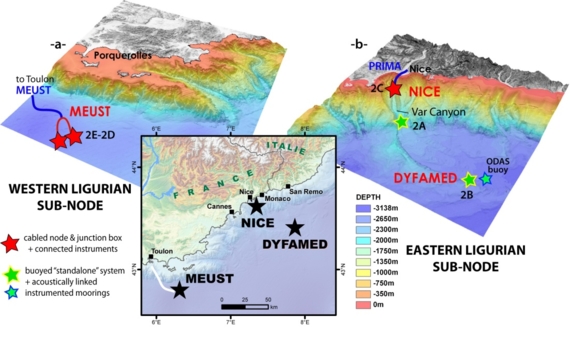Scientific objectives at Ligurian site
The Ligurian region has an active, if diffuse, seismicity (Béthoux et al., 2008). The continental slope is particularly narrow and steep, and rivers flow directly from nearby alpine reliefs. This promotes slope instability and the formation of submarine canyons. The Var canyon, offshore from Nice, is one of the most active in Europe, with turbidity currents that transfer large volumes of continent-derived material directly to the abyssal plain (Piper and Savoye, 1993). Water masses from the Tyrrhenian Sea, carried to the west by the Ligurian current (Crépon and Boukthir, 1987; Conan and Millot, 1995), meets and exchanges with waters from the Gulf of Lion in the Ligurian Sea. Changes in the intermediate and deep water masses have been interpreted as signals of changes in the deep-sea water formation in the Eastern Mediterranean Basin and of local climate changes (Smith et al., 2008; Marty and Chiaverini, 2010). The Ligurian Sea is also strongly influenced by atmospheric inputs triggering changes in biomass production (Marty et al., 2002). These specific conditions make the Ligurian region a unique location for a multidisciplinary long-term eulerian monitoring.
Scientific features at the Ligurian site:
- Slope failure processes on a steep continental slope
- Turbidity currents in submarine canyons and their force factors
- Seismic hazard, tsunami generation and the impact of seismicity on continental slope stability
- Marine biodiversity and life in deep oceanic environments
- Lateral and vertical dynamics of water masses and their impact on biochemical budgets
- Fluxes of organic matter through the water column, their impact on regional carbon budgets
Geographical location of the EMSO cabled and buoyed observatory infrastructures:
- ODAS Côte d'Azur buoy, presently operated by Météo France.
- Var canyon experiment (2A).
- DYFAMED and LION long term mooring (2B).
- EMSO-Nice cabled observatory (2C).
- SJB cabled add on extension to the neutrino telescope ANTARES (2D), moved to MEUST in 2017 (2E).
- ALBATROSS additional extension to the neutrino telescope moved from ANTARES to MEUST (2E).

